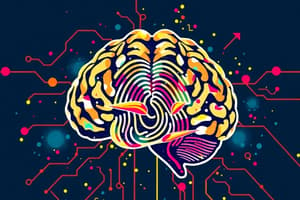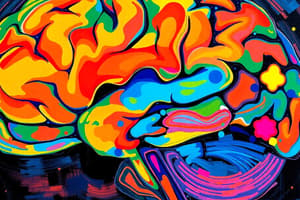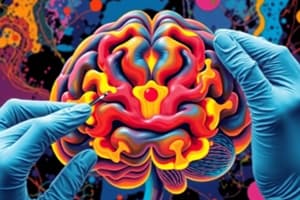Podcast
Questions and Answers
What is a major characteristic of brain areas according to the concept of pluripotentiality?
What is a major characteristic of brain areas according to the concept of pluripotentiality?
- They are limited to neuroplasticity only.
- They perform a single specific function.
- They can adapt to various functions. (correct)
- They remain constant throughout life.
What is a key limitation of post-mortem examinations within anatomical methods?
What is a key limitation of post-mortem examinations within anatomical methods?
- They allow for ethical evaluation during the procedure.
- They do not account for individual variability.
- They cannot observe real-time function. (correct)
- They provide real-time observation of brain function.
Which of the following is a significant issue when using correlational methods?
Which of the following is a significant issue when using correlational methods?
- They are limited by ethical concerns.
- They emphasize naturally occurring variations. (correct)
- They focus on causal relationships.
- They ensure ecological validity.
What do correlation methods primarily identify in relation to brain structure?
What do correlation methods primarily identify in relation to brain structure?
Which of the following represents a pro of anatomical methods?
Which of the following represents a pro of anatomical methods?
What is a disadvantage of using agonists in drug therapy?
What is a disadvantage of using agonists in drug therapy?
Which of the following studies suggests that increasing dopamine enhances working memory?
Which of the following studies suggests that increasing dopamine enhances working memory?
Which method is NOT commonly associated with causal research in neuroscience?
Which method is NOT commonly associated with causal research in neuroscience?
What effect does the use of antagonists have on neurotransmitter activity?
What effect does the use of antagonists have on neurotransmitter activity?
Which of the following terms refers to the ability of the brain to adapt and reorganize itself?
Which of the following terms refers to the ability of the brain to adapt and reorganize itself?
What is a primary advantage of using functional neuroimaging techniques such as fMRI?
What is a primary advantage of using functional neuroimaging techniques such as fMRI?
Which of the following is a significant disadvantage of cognitive assessments?
Which of the following is a significant disadvantage of cognitive assessments?
What is the main goal of causal methods in cognitive neuroscience?
What is the main goal of causal methods in cognitive neuroscience?
What is a key limitation of traditional cognitive assessment methods?
What is a key limitation of traditional cognitive assessment methods?
What was the focus of Joshua Greene’s research using fMRI?
What was the focus of Joshua Greene’s research using fMRI?
What is a major concern related to ecological validity in laboratory settings?
What is a major concern related to ecological validity in laboratory settings?
Which of the following is a potential issue when using controlled experiments?
Which of the following is a potential issue when using controlled experiments?
What bias is often associated with single-case studies?
What bias is often associated with single-case studies?
What is meant by practice effects in cognitive assessments?
What is meant by practice effects in cognitive assessments?
Which of these measurements is considered indirect?
Which of these measurements is considered indirect?
What is one challenge of animal models in research?
What is one challenge of animal models in research?
What type of measurement is often used in functional assessments?
What type of measurement is often used in functional assessments?
Which statement best describes the limitation of indirect measures?
Which statement best describes the limitation of indirect measures?
What is one major drawback of lesion analysis in studying the hippocampus?
What is one major drawback of lesion analysis in studying the hippocampus?
Which case study is linked to changes in personality and decision-making due to a frontal lobe injury?
Which case study is linked to changes in personality and decision-making due to a frontal lobe injury?
What is a common strength of case studies in neuroscience research?
What is a common strength of case studies in neuroscience research?
Which neuroimaging technique is commonly combined with cognitive tasks in behavioral studies?
Which neuroimaging technique is commonly combined with cognitive tasks in behavioral studies?
What is one limitation of behavioral studies when studying brain activity?
What is one limitation of behavioral studies when studying brain activity?
Who contributed to establishing the hippocampus as essential for memory through extensive cognitive testing?
Who contributed to establishing the hippocampus as essential for memory through extensive cognitive testing?
What is one potential issue with single-case studies in research?
What is one potential issue with single-case studies in research?
What did Michael Posner develop in relation to cognitive processes?
What did Michael Posner develop in relation to cognitive processes?
Flashcards are hidden until you start studying
Study Notes
Correlational Methods
- Observe relationships between brain structure and behaviour
- Focus on naturally occurring variations
- Techniques: Anatomical & behavioural methods
Anatomical Methods
- Post-Mortem Examinations: Direct examination of brain structures. Cons: Cannot observe real-time function.
- Case Studies: Detailed insights into rare or unique conditions. Cons: Limited generalizability, single-case bias.
- Animal Models: Can provide controlled experiments and study neuroplasticity. Cons: Ethical concerns, cross-species translation.
Behavioural Methods
- Combine cognitive tasks with neuroimaging
- Cognitive Assessments: Non-invasive, direct cognitive measurement. Cons: Practice effects, may lack real-world relevance.
- Functional Neuroimaging: Real-time brain activity, brain networks. Cons: Indirect measures, expensive, time-consuming.
Causal Methods
- Aim is to establish direct links between brain activity and cognitive function
- Manipulate brain regions or neurotransmitter systems to observe effects on behaviour
- Unlike correlational methods, causal approaches provide definitive evidence of how specific neural mechanisms support cognition.
Drug Administration
- Agonists: Enhance neurotransmitter activity (e.g., L-DOPA for dopamine).
- Antagonists: Inhibit neurotransmitter activity (e.g., Haloperidol).
Brain Regions Involved in Specific Functions
- The hippocampus is essential for memory.
- Three networks govern attention: alerting, orienting, and executive control.
- The frontal cortex is involved in personality and decision-making.
Key Terms
- Broca’s vs. Wernicke's Aphasias: Language disorders affecting speech production and comprehension.
- Ventral vs. Dorsal Stream: Pathways in the visual system involved in object recognition and spatial processing.
- Association: Connections between different brain regions, allowing combined function.
- Prefrontal Cortex: Involved in executive functions, planning, and decision-making.
- Pluripotentiality: Brain areas often perform various functions or adapt to various functions, reflecting neuroplasticity.
- Neuroplasticity: The brain's ability to change and adapt over time in response to experience.
- Luria’s functional systems theory: Brain functions are organized through a network of interacting areas, not isolated regions.
- Double Dissociation: Separate brain lesions affecting different functions in distinct ways, indicating different processes.
Important Issues
- Practice Effects: Repeated exposure to the same tasks can improve performance over time, skewing results.
- Ecological Validity: Laboratory settings don't always mimic the complexity of real-world environments.
- Ethical Concerns: Animal welfare and human subject safety.
- Cross Species Translation: The extent to which findings in animals can be applied to humans.
- Indirect Measurement: Neuroimaging techniques provide indirect measures of brain activity.
Methods Comparison
- Anatomical Methods: Detailed insights but limited generalizability and real-time function.
- Behavioural Methods: Non-invasive and direct cognitive measurement but vulnerable to practice effects and may lack real-world relevance.
- Causal Methods: Definitive evidence of brain-behaviour links but may have system-wide side effects and ethical concerns.
Studying That Suits You
Use AI to generate personalized quizzes and flashcards to suit your learning preferences.




